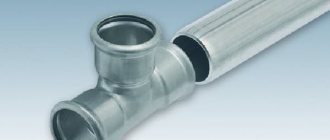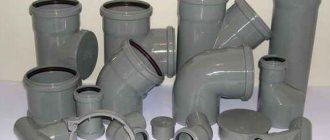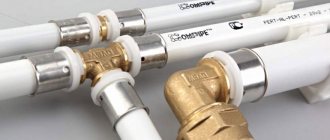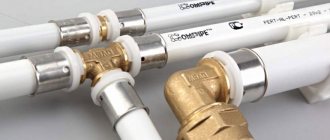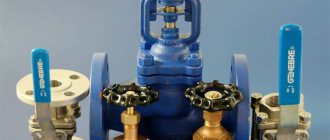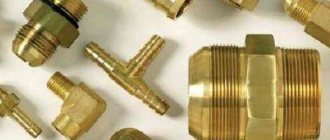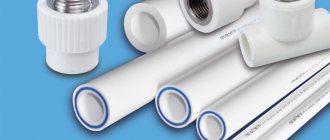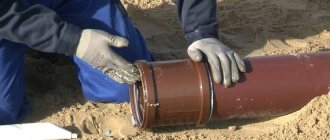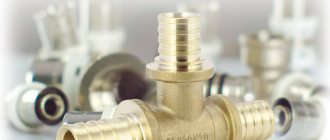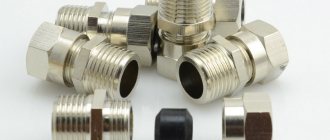The use of metal pipelines in households, despite being actively replaced by polymers, has still not lost its relevance. In addition to welding, threaded fittings for metal pipes are used to connect them, a catalog of which is provided to the buyer by all manufacturers of quality goods.
Before choosing a threaded connection for an assembled metal pipeline, the user has to consider and compare fittings designed for these purposes from a wide range of both domestic and foreign manufacturers. At the same time, in addition to the pricing policy of companies, due to the different materials used for making fitting connectors, various decision-making options are possible, from the most budgetary to the most costly.
Rice. 1 Examples of fitting connections
Classification of fittings
Polypropylene pipes and connecting elements are created from materials with different compositions. Therefore, they are characterized by thermal stability. This material property affects the classification and labeling of fittings and pipes.
Marking
PP pipes and fittings
PP pipeline parts are made from the following raw materials:
- Homopropylene is designated by the abbreviation PPG, and products made from it are marked PRN or PP-1.
- Random copolymer or static copolymer of polypropylene - abbreviated as PPR; when marking pipes and fittings the following designations are used: PP-3, PPRC, PPCR.
- Block copolymer (PPV) - for marking PP pipeline elements, the following abbreviations are used: RRV, RR-S, RR-2.
- Polyphenyl sulfide (PPS) - pipe parts made from it are marked (PPS).
The composition of the PPG material includes modifying additives that increase the impact strength of PP products. In addition, nucleators, fire retardants and substances that reduce static electricity.
Homopropylene is used to make pipes and fittings for external cold water supply networks, drainage and ventilation systems. The products are not used to create heating circuits for buildings because they have a low melting point.
Pipe parts made from PPG are often manufactured with large diameters. Therefore, they are used in drainage and sewer systems for industrial purposes.
Structure
The PPR material is distinguished by the crystalline structure of its molecules. Products made from random copolymer can withstand impacts and temperatures from -170°C to +1400°C.
Pipe products from this raw material are produced with a diameter of 16-110 mm. It is used for installation of heating, sewer and water supply systems in households and industrial facilities.
The PPV material is distinguished by its structure, consisting of precisely ordered homopolymer micromolecules forming blocks. Block copolymer products are characterized by high resistance to impact and high temperatures.
Therefore, heating systems in private houses and apartments are made from it. DHW and cold water circuits.
Polyphenyl sulfide has a different molecular structure and is a high-class polymer. As a result, they are characterized by excellent wear resistance, resistance to heat and heavy loads.
PPS pipes and fittings are created with a diameter of 20-1200 mm for water supply, ventilation and heating. PP products also differ from each other in their MRS characteristic - minimum duration of strength.
The indicator takes into account the wall thickness and allows you to select products based on the highest pressure in the network. Consequently, it will ensure reliable operation of the system for 50 years when moving water at a temperature of 20°C.
The maximum permissible pressure is indicated by the letters PN along with numbers. Thus, PN10 pipe elements can withstand the highest pressure load of 10 bar, and PN16 - 16 bar.
Scope of application of various connections for polyethylene pipes
The underlying material is polyethylene with various densities or brass. The diameters of the fittings used vary from 20 to 1200 mm. To familiarize yourself with all types and characteristics, you can refer to the following table:
| View | Characteristics and scope of application |
| Compression | Used to create a drinking water supply system. It withstands temperatures in the range of 0+45 degrees, pressure 10-16 Bar. Welding is used during installation |
| Electric welded | Using a heating element as a wire. Finds application in the manufacture of gasification systems |
| Metal | Suitable if there are additional elements from other materials |
| Cast | The manufacturing system is identical to the HDPE system, temperature 0-40 degrees is allowed |
| Segmental (welded) | It is made of separate segments that are connected into a single system. The connection part must allow for the organization of branches when creating a water supply system |
| Brass | It is reliable and tight. Used together with bushings, it reduces the risk of deformations; when using a compression fitting, it allows you to narrow the diameter of the pipe |
| 75mm HDPE pipe | Relevant for creating a free-flow sewer system |
Figure 9. Electric welded
Types and types of connection fittings
The English word "fit" means to gather. It is thanks to him that the fitting got its name. With the help of such connecting elements, pipes are joined in the same and different planes.
They allow you to create branched systems and avoid obstacles. When using fittings, pipes of the same or different diameters are joined.
Manufacturers produce threaded and soldered connecting elements. The first type allows you to connect polypropylene communications with steel pipes and fittings in the form of taps and valves.
The second type is intended for connecting polymer elements to each other by soldering. First of all, when using special welding equipment. It heats the parts, so their structure softens. Only after this the fitting can be put on the pipe.
Couplings and adapters
The simplest fitting for polypropylene pipes is a coupling. It is made in the form of a barrel, the internal diameter of which corresponds to the cross-sectional size of the pipe along the outer edge.
PP coupling
The couplings have thicker walls. They are used to connect pipes of the same diameter, inserted into the so-called barrel on both sides if it is made entirely of polypropylene. When the coupling is threaded, soldering is performed on one edge only.
Combined coupling PP
An adapter is an element that allows you to connect pipes of different diameters. Used in branched systems with several consumers.
Adapter PP
Using adapters, it is possible to narrow the diameter of the communication and create excess pressure in the circuit.
Angle, tee and cross
In most cases, utility lines have a branched structure. Angles are used to rotate the system 90° and 45°. They form a system of the required configuration. After all, polypropylene is a hard and elastic material that bends only after heating.
However, this method is not used when laying communications. As a result, when bending, the cross-sectional size and wall thickness of the pipes change. This reduces the strength characteristics of the system. Consequently, it often leads to the appearance of a leak when the pressure and temperature of the moving medium increases.
Corner pp
Angles are also available with a 3/4 female thread on one end. They are used during installation of mixers.
Tee pp
Tees and crosses are used to branch utility lines. They allow you to connect two or three taps together. The sizes of fittings for polyethylene pipes are selected depending on the design.
Crosspiece pp
Tees and crosses allow you to create bends at right or acute angles. This type of fitting is also available with threads on one end. In this case, they are used when installing shut-off valves.
Bypass and compensators
Bypasses are used to bypass obstacles on the way of laying systems. With their help, a more round bend is created than when using corners. Contours allow you to smoothly change the direction of pipelines. Therefore, it is possible to lay communications that have a more attractive and neat appearance.
PP bypass
Compensators are parts of engineering systems that can “absorb” pressure and temperature changes in hot water supply and heating pipelines. They increase reliability and maintain the integrity of networks. Several ready-made solutions are available. Polypropylene expansion joints are made in the form of a loop.
American fitting
The installation process of PP systems is made easier by the American. This is an element made of metal and plastic with a rubber insert. The parts are used for detachable sealed connections.
American pp
Such fittings with internal or external threads on one side are used when installing shut-off valves, hydraulic accumulators, circulation pumps, heating radiators, and so on.
Taps, valves and plugs
During the operation of utilities, it is often necessary to shut off the water. This is achieved by installing taps and valves. They can be made of polypropylene or brass.
Valve PP
In the first case, parts are soldered into systems. In the second, adapters are additionally used. Consequently, they allow threaded connections of network parts made of different materials.
Crane pp
Plugs are used in places where polypropylene pipelines end.
Plug PP
Such parts can be soldered to permanently block the outlet or temporarily installed using a threaded connection.
Subtleties of installing a crimp coupling
In a situation where the thread on a pipe has rotted and cutting it is impractical, a universal solution would be to install a crimp coupling.
Installing a crimp coupling is a win-win option in situations where you need to join pipes or connect equipment without involving threads
To correctly install the compression fitting, installation is performed in the following order:
- The pipe section to be joined is cleaned of burrs, treating both the outer and inner surfaces of the product.
- The end of the pipe is inserted into the fitting body, positioning it in such a way that the central part of the coupling strictly corresponds to the joint.
- A crimp ring is pulled onto the pipe.
- A crimp nut is placed on the resulting segment. As the nut moves along the thread, it will press the ferrule into the pipe, creating a tight connection.
When tightening the nut, do not use excessive force. Otherwise, the nut will compress the connection or simply burst.
Selection of fittings by diameter
When selecting connecting elements, a diagram of the engineering system is first created. It will allow you to find out the type of fittings for polypropylene pipes. The size of each part is selected taking into account the diameters of the connected pipes in a specific area.
When choosing fittings, you need to pay attention to the markings. It allows you to find out the outer diameter, taking into account the thick walls of the elements that affect the cross-country ability. For PP parts it is less than for metal-plastic products.
Systems made of polymer materials have a smoother internal surface compared to networks made of steel. Thanks to this feature, deposits do not accumulate in PP pipelines.
Therefore, plastic communications are able to move more liquid. For example, than steel systems of identical diameter in the same time.
Indoor water supply is usually installed from PP pipes with a diameter of 20 mm. In cottages, systems may have a larger cross-sectional size, depending on the number of water points. Therefore, most often when installing a water supply system, fittings with a diameter of 20-40 mm are used.
Technical specifications
Fittings are classified based on technical criteria:
- What technical role requires the installation of fastenings - fittings;
- What material is the structure made of?
- How will the mount be fixed;
- Distinctive design features and size.
The size range starts from 4 - 600 mm and depends on the intended purpose (connecting brake hoses or preparing a main pipeline). It is customary to distinguish several standard sizes of fittings: 20, 25, 50, 110 and 32mm. As a rule, due to their great popularity, such models are not difficult to find.
What else to consider when choosing fittings
Connecting pipeline parts are selected taking into account the type of designed engineering system. When purchasing fittings, you must take into account the following nuances:
- For PP water supply, the elements are white or gray.
- Installation work is carried out using special pipe cutters and soldering irons specifically for PP pipes.
- For communications made of polypropylene, it is necessary to purchase connecting parts from the same material. They cannot be replaced with PVC fittings.
It is recommended to buy polypropylene pipes and fittings from well-known manufacturers. In addition, the brands’ products are distinguished by their neat appearance, large assortment, and availability of all standard sizes.
Fittings for pp pipes
You should also pay attention to the SDR indicator, which characterizes the cross-country ability of products. Parts with a high value of this characteristic have good maneuverability and relatively thin walls.
Pipeline products with a small SDR have low permeability, but are characterized by increased strength and density.
Typology
For competent and high-quality installation of plumbing, it is impossible to do without connecting elements. The basis is often durable metal - steel, cast iron, metal, brass. No less common are structures made of plastic and synthetic materials: polyvinyl chloride, polypropylene, polyethylene.
Considering the diverse design of the fitting system for heated towel rails, several options can be distinguished:
- Threaded connection
Fig 2. With thread - Compression.
- With capillary soldering.
- Press.
- Self-locking.
To build a reliable water supply system, several types are used at once:
- If the section is straight, a coupling is relevant;
- If the system is branched - a tee or cross;
- To change the direction of flow - diversion.
How to choose the best PP option
*
In order not to make a mistake and choose the best fittings, it is recommended to take into account the material from which the connection is made and its diameter for:
- organization of durable structures made of copper or steel - flanges. They are suitable if it is impossible to avoid welding work or if the components have threads. When ordering a batch, you need to consider how flat they are and whether the ends are perpendicular. These indicators determine how tight the connection will be. To achieve tightness, it is better to use a special FUM tape. The locknut will help to achieve optimal fixation of the seal made of various metals (cast iron, steel or bronze).
- solving plumbing problems, it is better to select connecting elements from the same material as pipes. As a rule, it is PVC. Soldering is carried out using special tools. It is important to take into account that such models are characterized by high cost.
- systems with metal-plastic present, it is better to use several fasteners, on average 3-4. When ordering them, it is important to consider the weight. As a rule, the better the design, the more it weighs.
It is not recommended to save on the purchase of connecting elements, since the likelihood of serious leaks and pipe deformations depends on them. This is especially true for systems that must withstand high pressure.
The popularity of polymer models, which differ from the above categories in ease (you can install them yourself without the help of a team of professionals), durability (on average 30-40 years without replacement), allows the creation of water supply systems of various levels of complexity. However, it is also necessary to take into account the specifics of the planned work and the material from which the pipes are made and their diameter in order to ensure tightness and maximum tightness of the connections.

